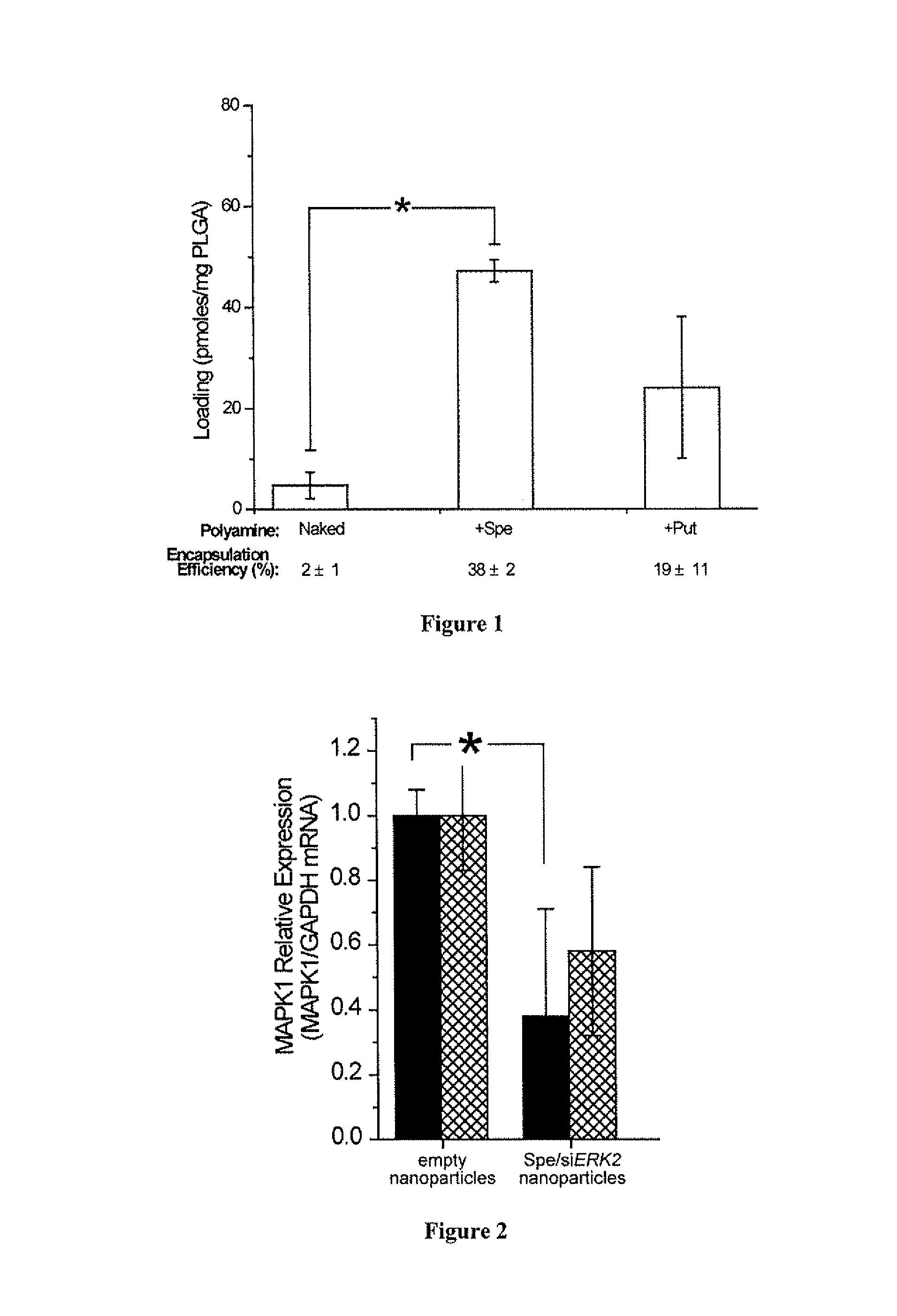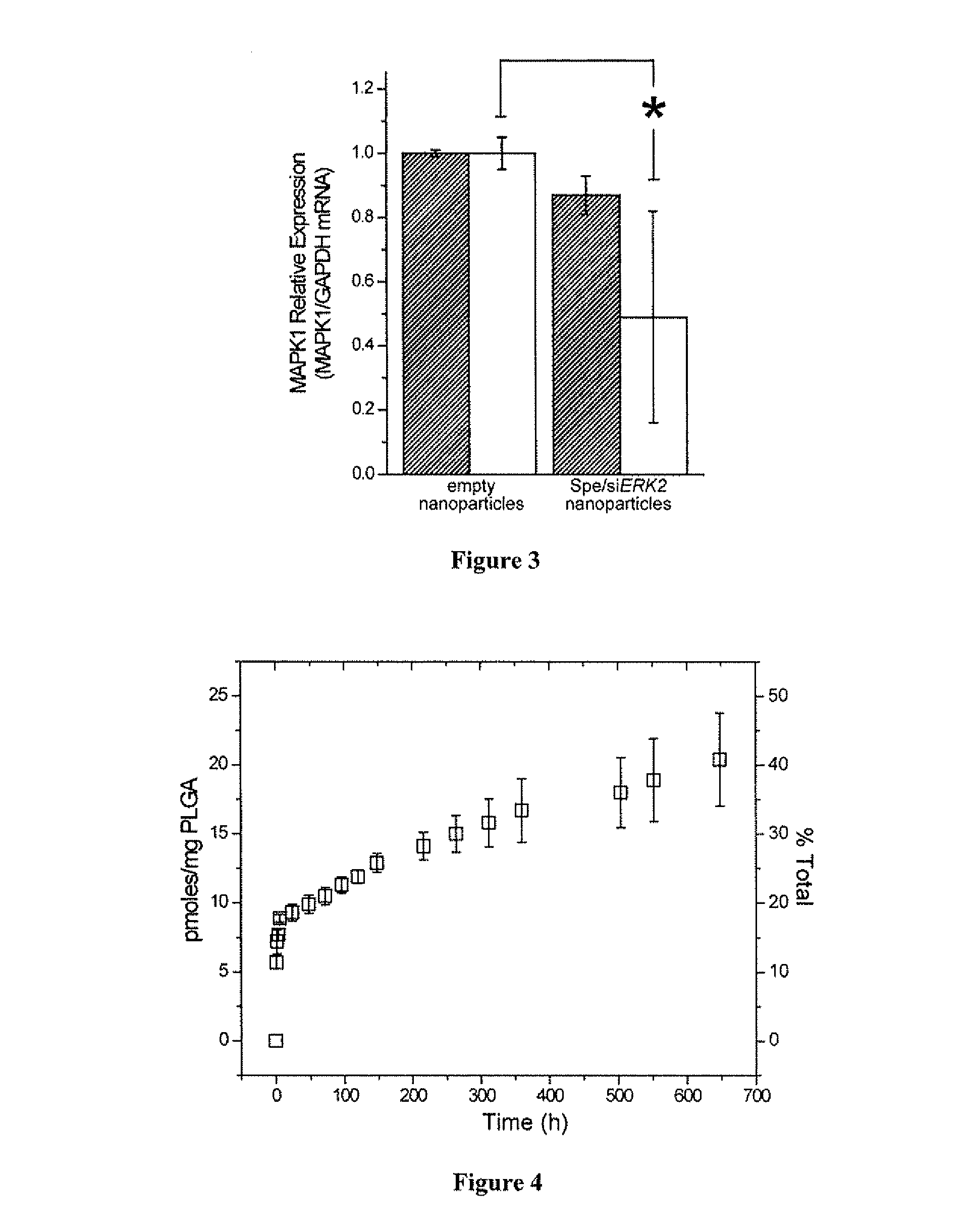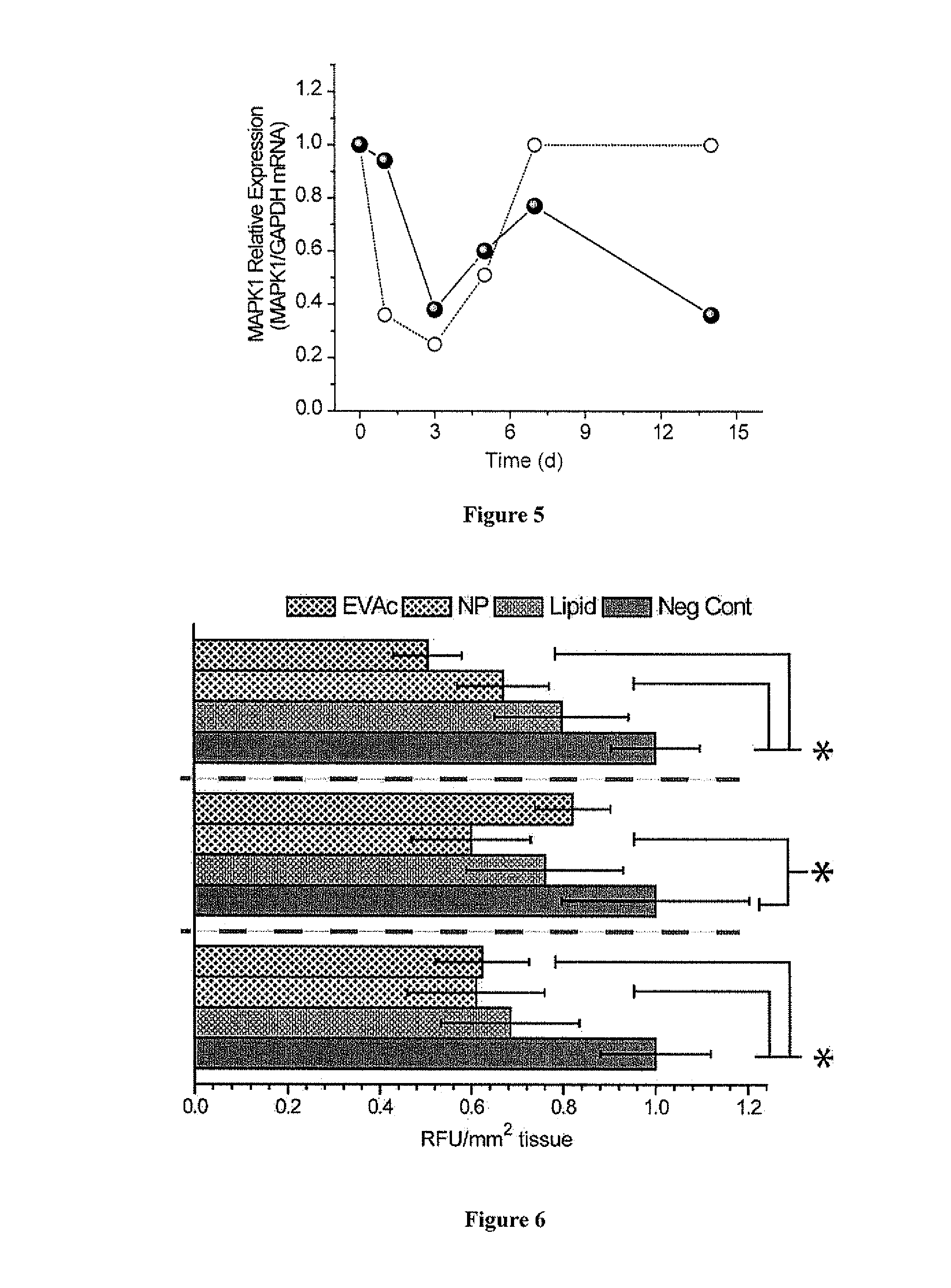Compositions and methods for controlled delivery of inhibitory ribonucleic acids
a technology of inhibitory ribonucleic acids and nanoparticulates, which is applied in the direction of drug compositions, immunological disorders, transferases, etc., can solve the problems of inhibiting rnas that are administered, limited rnai-based therapies in clinics, and the degradation of most subjects
- Summary
- Abstract
- Description
- Claims
- Application Information
AI Technical Summary
Benefits of technology
Problems solved by technology
Method used
Image
Examples
example 1
Encapsulation of siRNAs into Nanoparticles
[0217]Materials and Methods:
[0218]siRNAs. siRNAs were synthesized using 2′-O-ACE-RNA phosphoramidites (A4 grade, Dharmacon Research). siRNAs sequences directed against erk2 and EGFP were as previously described (Novina, et al., Nat. Med., 8:681-6 (2002); Sun, et al., Am. J. Physiol. Regul. Integr. Comp. Physiol., 293(3):R1239-46 (2007)). The sense and anti-sense strands of siRNAs used in these studies are listed in Table 1.
[0219]
TABLE 1Sequence and properties of siRNAsGC-contentBasesNameSequencea (5′→3′)(%)(nt)TargetdeoMMCd(GGCUACGUCCAGGAGCGCACC)7121siRNA(SEQ ID NO: 1)mimicsiERK2r(UGCUGACUCCAAAGCUCUG)d(TT)4821Mitogen-(SEQ ID NO: 2)activatedproteinkinase 1siEGFPr(GGCUACGUCCAGGAGCGCACC)7121Enhanced(SEQ ID NO: 3)greenfluorescentproteinaSequence indicates use of deoxyribonucleotides (d) or ribonucleotides (r).
[0220]Preparation of siRNA Nanoparticles. Polyamine Complexes with siRNA were formed at room temperature for 15 min on a rotary shaker. Th...
example 2
siRNA Nanoparticle Efficacy in Cultured Cells
[0227]Materials and Methods:
[0228]Cell lines. HepG2 hepatocytes (courtesy of Yale Liver Center) were maintained in Eagle's minimum essential medium (E-MEM, ATCC) supplemented with 10% (v / v) fetal bovine serum (FBS, Sigma) and 1% (v / v) penicillin / streptomycin (Sigma). NIH / 3T3 fibroblast were maintained in Dulbecco's Modified Eagle's Medium with high glucose (DMEM / High) supplemented with 10% (v / v) PBS and 1% (v / v) penicillin / streptomycin. HeLa cells were maintained in RPMI-1640 supplemented with 10% (v / v) FBS and 1% (v / v) penicillin / streptomycin.
[0229]In vitro controlled release. Nanoparticles (10-15 mg) were suspended in 1.0 mL of phosphate buffer (pH 7.4), and incubated at 37° C. with gentle shaking (70 rpm). Release of siRNA was monitored at several time intervals over 30 days. At each sampling time, the nanoparticle suspension was centrifuged for 5 min at 14,000 rpm. The supernatant (0.5 mL) was removed for quantification of fluorescenc...
example 3
siRNA Nanoparticle Efficacy In Vivo
[0236]Materials and Methods:
[0237]EVAc Disc. Poly Ethylene vinyl acetate (“EVAc”) discs were prepared by solvent evaporation as described by Luo, et al., Pharm. Res., 16(8):1300-8 (1999); Shen, et al., J. Control. Release, 86(2-3):339-48 (2003). Prior to encapsulation, siRNA was complexed with RNAiMax (Invitrogen). Equal volumes of siRNA (80 μM in OptiMEM) and RNAiMax (diluted 4 parts reagent and 1 part OptiMEM or 800 μL / mL) were combined and incubated at room temperature for 20 minutes. A 20% (wt / vol) Ficoll 70 (Sigma) in OptiMEM was added for a final concentration of 30 μM siRNA complexes and 5% (wt / vol) Ficoll 70. The mixture was flash frozen and lyophilized for 48 hours. The dried mixture of sugar and complexes was ground to a fine powder. The powder was added to poly(ethylene-co-vinyl acetate) dissolved in methylene chloride at 10% (w / v), vortexed, and poured into a mold chilled on dry ice. Once polymer / sugar / complexes matrix set, it was trans...
PUM
| Property | Measurement | Unit |
|---|---|---|
| diameter | aaaaa | aaaaa |
| diameter | aaaaa | aaaaa |
| concentration | aaaaa | aaaaa |
Abstract
Description
Claims
Application Information
 Login to View More
Login to View More - R&D
- Intellectual Property
- Life Sciences
- Materials
- Tech Scout
- Unparalleled Data Quality
- Higher Quality Content
- 60% Fewer Hallucinations
Browse by: Latest US Patents, China's latest patents, Technical Efficacy Thesaurus, Application Domain, Technology Topic, Popular Technical Reports.
© 2025 PatSnap. All rights reserved.Legal|Privacy policy|Modern Slavery Act Transparency Statement|Sitemap|About US| Contact US: help@patsnap.com



